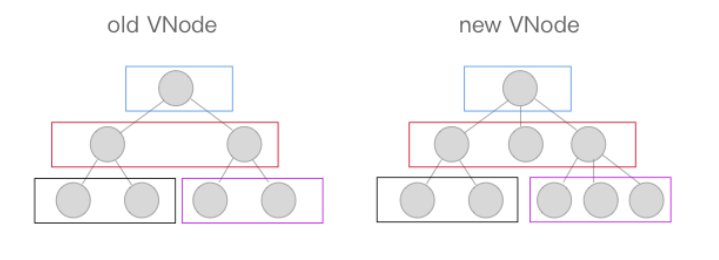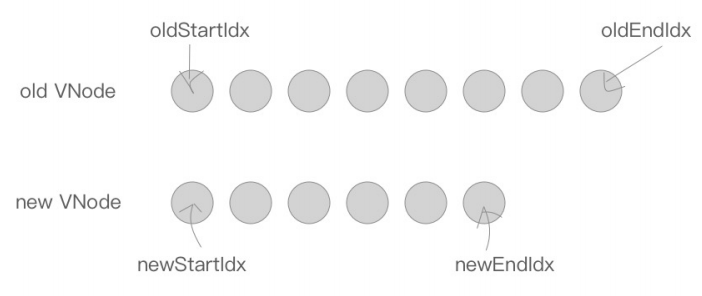1. Virtual dom
patch(vnode, h('div#app', obj.foo)) 2. Cross platform: convert virtual dom updates to different runtime special operations to achieve cross platform
const patch = init([snabbdom_style.default])
patch(vnode, h('div#app', {style:{color:'red'}}, obj.foo))three Compatibility: you can also add compatibility codes to enhance the compatibility of operations
1.1 comparison between real dom and virtual dom
Real dom
<div>
<p>Hello World</p>
</div>Virtual dom
let vnode = {
tag: 'div',
children:[ {tag:'p', text:'Hello World'}]
}2. diff algorithm
2.1 patch function
2.1.1 patch implementation
File patch core\vdom\patch.js

return function patch (oldVnode, vnode, hydrating, removeOnly) {
// If the new virtual dom tree does not exist, it is deleted
if (isUndef(vnode)) {
if (isDef(oldVnode)) invokeDestroyHook(oldVnode)
return
}
let isInitialPatch = false
const insertedVnodeQueue = []
// If the old vdom does not exist, add a new one
if (isUndef(oldVnode)) {
// empty mount (likely as component), create new root element
isInitialPatch = true
createElm(vnode, insertedVnodeQueue)
} else {
// If the real node is passed in, the initialization operation is performed
const isRealElement = isDef(oldVnode.nodeType)
if (!isRealElement && sameVnode(oldVnode, vnode)) {
// patch existing root node
// There are old and new vdom s
patchVnode(oldVnode, vnode, insertedVnodeQueue, null, null, removeOnly)
} else {
// During initialization, create a new dom, append it to the body, and delete the array
if (isRealElement) {
// mounting to a real element
// check if this is server-rendered content and if we can perform
// a successful hydration.
// If there is a real node, there is the data server render attribute
if (oldVnode.nodeType === 1 && oldVnode.hasAttribute(SSR_ATTR)) {
// When the old Vnode is a rendering element on the server side, hydrating is marked as true
oldVnode.removeAttribute(SSR_ATTR)
hydrating = true
}
// You need to map the virtual DOM to the real DOM with the hydrate function
if (isTrue(hydrating)) {
// It needs to be merged into the real DOM
if (hydrate(oldVnode, vnode, insertedVnodeQueue)) {
// Call insert hook
invokeInsertHook(vnode, insertedVnodeQueue, true)
return oldVnode
} else if (process.env.NODE_ENV !== 'production') {
warn(
'The client-side rendered virtual DOM tree is not matching ' +
'server-rendered content. This is likely caused by incorrect ' +
'HTML markup, for example nesting block-level elements inside ' +
'<p>, or missing <tbody>. Bailing hydration and performing ' +
'full client-side render.'
)
}
}
// either not server-rendered, or hydration failed.
// create an empty node and replace it
// If it is not a server-side rendering element or merging to the real DOM fails, create an empty Vnode node to replace it
oldVnode = emptyNodeAt(oldVnode)
}
// replacing existing element
const oldElm = oldVnode.elm
const parentElm = nodeOps.parentNode(oldElm)
// create new node
createElm(
vnode,
insertedVnodeQueue,
// extremely rare edge case: do not insert if old element is in a
// leaving transition. Only happens when combining transition +
// keep-alive + HOCs. (#4590)
oldElm._leaveCb ? null : parentElm,
nodeOps.nextSibling(oldElm)
)
// update parent placeholder node element, recursively
if (isDef(vnode.parent)) {
let ancestor = vnode.parent
const patchable = isPatchable(vnode)
while (ancestor) {
for (let i = 0; i < cbs.destroy.length; ++i) {
cbs.destroy[i](ancestor)
}
ancestor.elm = vnode.elm
if (patchable) {
for (let i = 0; i < cbs.create.length; ++i) {
cbs.create[i](emptyNode, ancestor)
}
// #6513
// invoke insert hooks that may have been merged by create hooks.
// e.g. for directives that uses the "inserted" hook.
const insert = ancestor.data.hook.insert
if (insert.merged) {
// start at index 1 to avoid re-invoking component mounted hook
for (let i = 1; i < insert.fns.length; i++) {
insert.fns[i]()
}
}
} else {
registerRef(ancestor)
}
ancestor = ancestor.parent
}
}
// destroy old node
if (isDef(parentElm)) {
removeVnodes([oldVnode], 0, 0)
} else if (isDef(oldVnode.tag)) {
invokeDestroyHook(oldVnode)
}
}
}
invokeInsertHook(vnode, insertedVnodeQueue, isInitialPatch)
return vnode.elm
}3. patchVnode
let i
const data = vnode.data
if (isDef(data) && isDef(i = data.hook) && isDef(i = i.prepatch)) {
i(oldVnode, vnode)
}
// Check whether the old and new nodes have child queues
const oldCh = oldVnode.children
const ch = vnode.children
// Attribute update
if (isDef(data) && isPatchable(vnode)) {
for (i = 0; i < cbs.update.length; ++i) cbs.update[i](oldVnode, vnode)
if (isDef(i = data.hook) && isDef(i = i.update)) i(oldVnode, vnode)
}
// Judge whether it is an Element. If there is no text, it is an Element
if (isUndef(vnode.text)) {
// All have children
if (isDef(oldCh) && isDef(ch)) {
if (oldCh !== ch) updateChildren(elm, oldCh, ch, insertedVnodeQueue, removeOnly)
} else if (isDef(ch)) {
// Only new nodes have children
if (process.env.NODE_ENV !== 'production') {
checkDuplicateKeys(ch)
}
// Empty old node text
if (isDef(oldVnode.text)) nodeOps.setTextContent(elm, '')
// Add child
addVnodes(elm, null, ch, 0, ch.length - 1, insertedVnodeQueue)
} else if (isDef(oldCh)) {
// Only the old node has children
removeVnodes(oldCh, 0, oldCh.length - 1)
} else if (isDef(oldVnode.text)) {
// Old node has text
nodeOps.setTextContent(elm, '')
}
} else if (oldVnode.text !== vnode.text) {
// Both old and new are text and different
nodeOps.setTextContent(elm, vnode.text)
}
if (isDef(data)) {
if (isDef(i = data.hook) && isDef(i = i.postpatch)) i(oldVnode, vnode)
}
}4. updateChildren
Here comes the point!!!!

There are four situations:
1. The old node is the same as the new header node, and directly patchVnode
2. The old tail node is the same as the new tail node, directly patchVnode
3. The old node is the same as the new tail node. While patchVnode, the old node should be placed behind the old tail node
4. The old tail node is the same as the new head node. While patchVnode, place the old tail node in front of the old node
If none of the above four conditions are met:
In the old node queue, look for the node that satisfies sameVnode with the new head node, and then move it to the front of the old node, and the subscript of the new head node moves back one bit
Of course, if such a node cannot be found, create a new node and put it at the front of the old node queue
Finally, the queue lengths of the old node and the new node may be different, and there will be one queue that has not been traversed, so there will be the following two cases:
Batch addition (after traversing the old nodes, new nodes that have not been traversed will be created and added in batch)
Batch deletion (after traversing the new nodes, delete the old nodes that have not been traversed in batch)
Direct source code
function updateChildren (parentElm, oldCh, newCh, insertedVnodeQueue, removeOnly) {
let oldStartIdx = 0
let newStartIdx = 0
let oldEndIdx = oldCh.length - 1
let oldStartVnode = oldCh[0]
let oldEndVnode = oldCh[oldEndIdx]
let newEndIdx = newCh.length - 1
let newStartVnode = newCh[0]
let newEndVnode = newCh[newEndIdx]
let oldKeyToIdx, idxInOld, vnodeToMove, refElm
// removeOnly is a special flag used only by <transition-group>
// to ensure removed elements stay in correct relative positions
// during leaving transitions
const canMove = !removeOnly
if (process.env.NODE_ENV !== 'production') {
checkDuplicateKeys(newCh)
}
/**
* Both sides close to the middle, dfs
*/
while (oldStartIdx <= oldEndIdx && newStartIdx <= newEndIdx) {
if (isUndef(oldStartVnode)) {
// The old start node does not exist. Move the subscript one bit back
oldStartVnode = oldCh[++oldStartIdx] // Vnode has been moved left
} else if (isUndef(oldEndVnode)) {
// The old tail node does not exist. The subscript moves forward one bit
oldEndVnode = oldCh[--oldEndIdx]
} else if (sameVnode(oldStartVnode, newStartVnode)) {
// The old and new start nodes are the same and + 1 at the same time
patchVnode(oldStartVnode, newStartVnode, insertedVnodeQueue, newCh, newStartIdx)
oldStartVnode = oldCh[++oldStartIdx]
newStartVnode = newCh[++newStartIdx]
} else if (sameVnode(oldEndVnode, newEndVnode)) {
// The old and new end nodes are the same, and - 1
patchVnode(oldEndVnode, newEndVnode, insertedVnodeQueue, newCh, newEndIdx)
oldEndVnode = oldCh[--oldEndIdx]
newEndVnode = newCh[--newEndIdx]
} else if (sameVnode(oldStartVnode, newEndVnode)) {
// The old head node is the same as the new tail node. Move the old head node to the old tail to improve the similarity
// Vnode moved right
patchVnode(oldStartVnode, newEndVnode, insertedVnodeQueue, newCh, newEndIdx)
canMove && nodeOps.insertBefore(parentElm, oldStartVnode.elm, nodeOps.nextSibling(oldEndVnode.elm))
oldStartVnode = oldCh[++oldStartIdx]
newEndVnode = newCh[--newEndIdx]
} else if (sameVnode(oldEndVnode, newStartVnode)) {
// The old tail node is the same as the new head node
// Vnode moved left
patchVnode(oldEndVnode, newStartVnode, insertedVnodeQueue, newCh, newStartIdx)
canMove && nodeOps.insertBefore(parentElm, oldEndVnode.elm, oldStartVnode.elm)
oldEndVnode = oldCh[--oldEndIdx]
newStartVnode = newCh[++newStartIdx]
} else {
// The four conjectures did not find the same, so they were forced to search circularly
if (isUndef(oldKeyToIdx)) oldKeyToIdx = createKeyToOldIdx(oldCh, oldStartIdx, oldEndIdx)
// Find the index key in the old array
idxInOld = isDef(newStartVnode.key)
? oldKeyToIdx[newStartVnode.key]
: findIdxInOld(newStartVnode, oldCh, oldStartIdx, oldEndIdx)
// If there is no such element in the old child node array, a new one will be created
if (isUndef(idxInOld)) { // New element
createElm(newStartVnode, insertedVnodeQueue, parentElm, oldStartVnode.elm, false, newCh, newStartIdx)
} else {
// If the element is found to be reusable, further comparison is made
vnodeToMove = oldCh[idxInOld]
if (sameVnode(vnodeToMove, newStartVnode)) {
// Is exactly the same element
patchVnode(vnodeToMove, newStartVnode, insertedVnodeQueue, newCh, newStartIdx)
oldCh[idxInOld] = undefined
canMove && nodeOps.insertBefore(parentElm, vnodeToMove.elm, oldStartVnode.elm)
} else {
// Only the key is the same, but the content is different
// same key but different element. treat as new element
createElm(newStartVnode, insertedVnodeQueue, parentElm, oldStartVnode.elm, false, newCh, newStartIdx)
}
}
newStartVnode = newCh[++newStartIdx]
}
}
// Finally, finish the work
if (oldStartIdx > oldEndIdx) {
refElm = isUndef(newCh[newEndIdx + 1]) ? null : newCh[newEndIdx + 1].elm
// Batch creation
addVnodes(parentElm, refElm, newCh, newStartIdx, newEndIdx, insertedVnodeQueue)
} else if (newStartIdx > newEndIdx) {
// Batch delete
removeVnodes(oldCh, oldStartIdx, oldEndIdx)
}
}